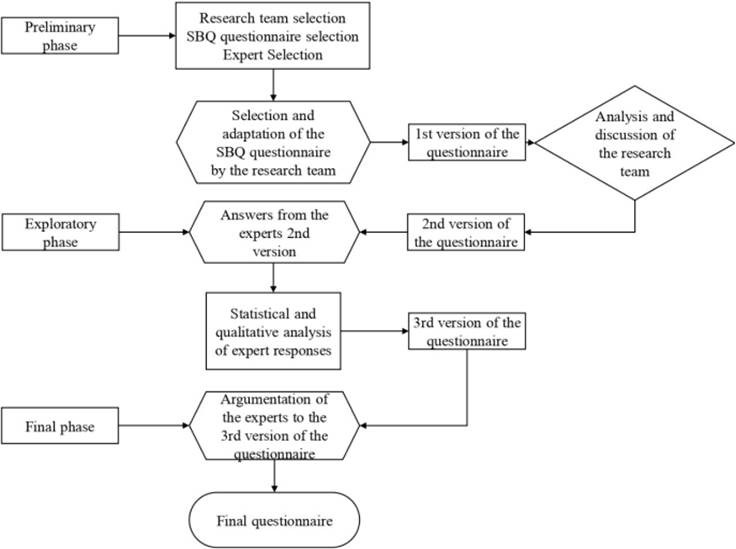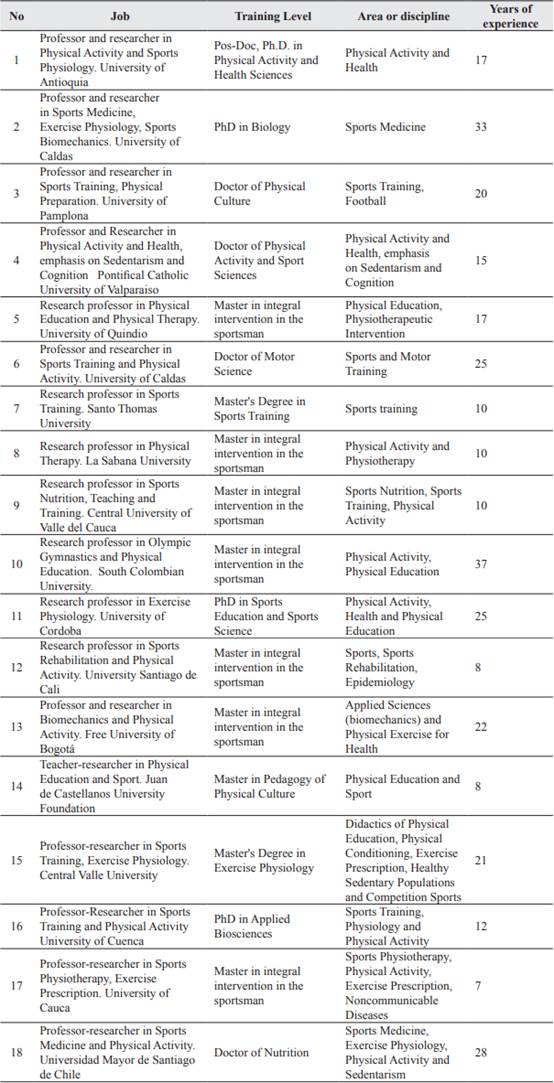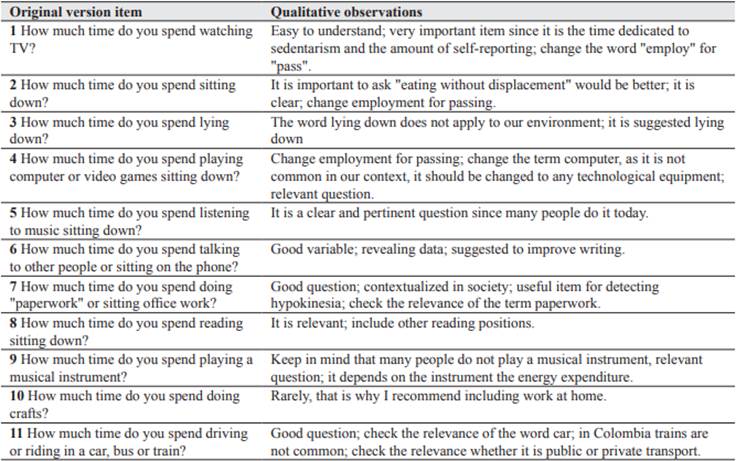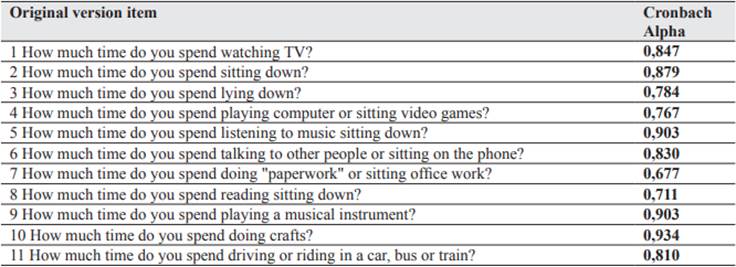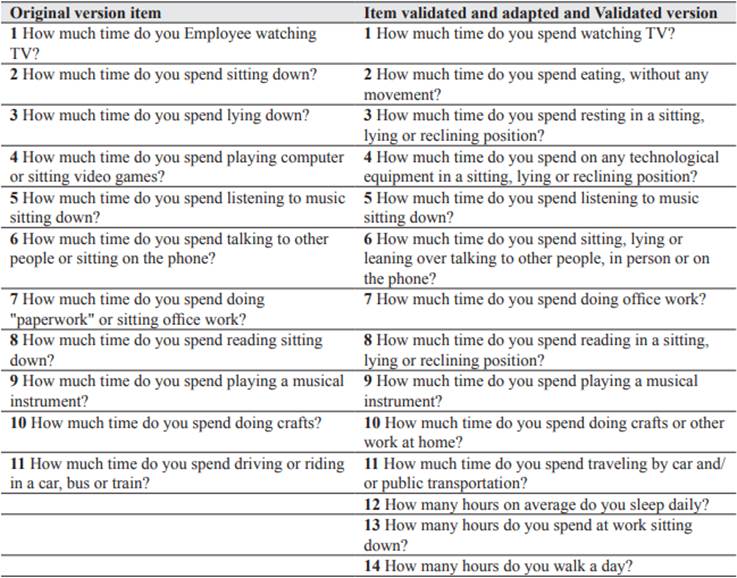Introduction
The body movements that are produced by muscular action are defined as physical activity, which leads to energy consumption, a broad and encompassing concept that becomes a protective factor to prevent pathologies generated by inappropriate habits and lifestyles, such as the consumption of psychoactive substances, stress, environmental pollution, unbalanced diets, and sedentary behaviors, among others 1. The study of this last behavior is particularly relevant since physical inactivity, which leads to sedentary lifestyle, has been identified as a factor that contribute significantly to the cause of diseases such as diabetes, cardiovascular disease, osteoporosis and dyslipidemia, among others 2. Sedentary lifestyle includes activities such as sitting, watching television, and driving, among others, and has been defined based on activities associated with an energy expenditure < 1.5 METs (MET = basal metabolic equivalent; 1 MET = ~ 3.5 mlO2 / kg / min) 3.
Sedentarism is now part of the daily lifestyles of children, young people and adults, mainly because people are increasingly staying at their desktops or with their technological equipment 2. According to the WHO, at least 60% of the world’s population is sedentary, with adults and the elderly being the most affected 4. The poor practice of physical activity and physical exercise, with low intensity and frequency, make sedentary lifestyle a public health problem 5. In Colombia, by 2018, 43.1% of people between 18 to 64 years old did not comply with physical activity recommendations 6. The foregoing supports the emerging need for health and physical activity and sport professionals to generate new knowledge about sedentary behaviors and how they are expressed in populations in their lifetime.
Sedentary behavior is one that requires very little energy expenditure, it is also defined as the time in which people remain sitting, lying down or at rest, it is directly related to physical inactivity and with the greater probability of suffering chronic not transferable diseases as mentioned above 7.
One of the tools that has been used to support the analysis of sedentary behaviors is the Sedentary Behavior Questionnaire (SQB) designed in the United States in 2010 8, in order to assess the amount of time spent on 9 behaviors (watching television, playing computer games, listening to music, talking on the phone, doing office work, reading, playing an instrument, doing arts or crafts, driving a car, bus or train), items that are evaluated separately for the days of the week and the weekend 9.
The SBQ has proven validity and reliability in countries like the United States 8,10, Singapore 11, Turkey 12 and Spain 13.
Although the instrument has been validated in Spain, in its Spanish version there are terms that, in the opinion of the researchers, require revision and adaptation for the Colombian context where it has not been validated. This process allows making objective and accurate critical judgments about whether what is actually measured is valid - it measures what it should measure - and if it is really supported by empirical evidence. It also allows having an instrument adapted to the geographical and cultural reality, which finally translates into results with a lower margin of application error in future research. 14-16.
Therefore, this work aims to adapt and validate the content of the SBQ Spanish version in order to have an instrument that evaluates sedentary behaviors in the Colombian population.
Materials and methods
Participants
Following the procedural indications to achieve a reliable content validation product by Delphi technique, two groups were defined: the research group made up of professors from the Physiotherapy program of the University of Boyacá and by professors from the Human movement and health departments of the Autonoma University of Manizales. They consolidated and analyzed the results of the work developed by the experts who met the inclusion criteria to issue adequate concepts that would contribute to the achievement of the objective, since they were professionals with updated knowledge and experience in the subject of interest.
Twenty-six potential experts were selected, they should have the following characteristics:
Academic training: doctor or master’s degree.
Training and / or academic experience in the area of physical activity and sport or related areas.
Experience in the area for at least 5 years as a teacher or researcher.
They were sent the informed consent, assessment tool and format via email. Finally, 18 experts responded.
Questionnaire
The SBQ was initially designed to assess the amount of time spent on 9 behaviors, which are: watching television, playing computer games, listening to music, talking on the phone, doing office work, reading, playing an instrument, doing arts and crafts, driving a car, bus or train. These activities were discriminated by day of the week and weekend, and given the questionnaire ease of application, it has been used in different populations with different health conditions and life cycles 8,11-13,17.
We started from the Spanish version, it had been objectively translated following the cross-cultural adaptation guidelines, in the Spanish version 2 questions had been added to the questionnaire, after determining that the reliability and general interclass correlation of the SBQ questionnaire were excellent with an interval between 0.83 - 0.86 and in relation to the questions. Those indices ranged from moderate to excellent in 10 of the 11 sedentary behaviors (0.52 to 0.96) 13.
For the present research and taking into account the above-mentioned factors, the instrument was retaken in the version validated in Spain that has 11 items and can be self-completed or applied by a researcher. However, it is necessary to adapt and validate its content to In the Colombian context, it should be clarified that according to the original instrument, the same questions are asked in two contexts like this: Monday through Friday, on a typical weekday, from the moment he gets up until he goes to bed (at night). On the weekend, on a typical weekend day, from waking up to going to bed (at night).
Process
The procedure was defined taking Blasco et al 18 and Bravo et al 19 as a reference. They propose three fundamental phases (preliminary, exploratory and final) for the development of the Delphi technique (Figure 1).
Preliminary phase:
The instrument was selected, the research team and the group of experts were consolidated. To select the questionnaire, a search was carried out in different databases and repositories of instruments whose inclusion criterion was that they would evaluate the different sedentary behaviors and take into account the new dispositions and terminologies of sedentary lifestyle. The keywords used for the search were: sedentary behavior, surveys and questionnaires, physical activity, motor activity, Boolean connectors such as “and”, “or” were used.
The questionnaire, research group and expert group were identified; for the selection of the questionnaire, a search of different bibliographic sites was done and developed on instruments that assess the different sedentary behaviors and that take into account the new provisions and terminologies of sedentarism.
The searches were carried out in Google Schoolar, Scielo, Medline, Ovid, ScienceDirect, which allowed to identify research works that studied habits and lifestyles such as physical activity, sports, and nutrition, among others, in which different instruments had been used. The IPAQ (International Physical Activity Questionnaire) stands out, it has been evaluated, used and recommended by the European Physical Activity Surveillance System (EUPASS) 21 and the SF-36 that aims to know the quality of life related to health in the participating subjects, being this reliable for the Colombian population 22-23.
With the analysis of these findings, it was possible to identify that in Colombia there is no validated questionnaire that evaluates sedentary behaviors, an aspect considered a problem in current generations especially due to behaviors such as increased time in front of screens and low levels of physical activity, which results in a lower energy expenditure than recommended, that is, 1.5 MET equivalents 22-24.
This led the research team to discuss and make changes to the initial version of the SBQ based on the bibliographic review in order to have the second version of the instrument that would be subject to evaluation by experts.
Exploratory phase:
The first version of the questionnaire, as previously mentioned, had some changes and a second version in a better format was consolidated. Then, it was sent to the experts who agreed to participate in the study via email and they were given a maximum response time of 15 days, anonymity was always preserved; The experts made the necessary recommendations in a pre-established template that evaluated the criteria of relevance, usefulness, clarity, written form and extension in each item, making reference to facial validity, each of the items and the criteria was evaluated in a Likert scale like this:
1 = Does not meet the criteria
2 = Low level of compliance
3 = Moderate level of compliance
4 = High level of compliance
Upon obtaining the evaluation of the group of experts, the research team tabulated and analyzed it in the SPSS V.24 program licensed by the Autonoma University of Manizales for its quantitative component. The recommendations given from the qualitative point of view and the adjustments suggested by the researchers to improve the understanding and quality of the questionnaire were made. The internal consistency of the questionnaire was evaluated through Cronbach’s alpha by considering the reference points reported by Landis and Koch 25. A third version was obtained in this way.
Final phase:
This third version was discussed in the research group and, based on this last assessment, the final version of the questionnaire was structured. It consists of 14 items that can be used in the different research processes aimed at assessing sedentary behaviors in the Colombian population.
Results
Preliminary phase
The theoretical review carried out suggested some form adjustments that were made to the version adapted to Spanish. The research group selected the participants from the analysis of the criteria defined in the methodology; thus, experts from the discipline with more than 5 years of experience in academic, practical and research work in the area of Physical Activity and Sport participated. The 18 experts worked in different academic institutions, the level of training was Master’s degree (55.6%) and / or doctoral studies (44.4%), the years of experience ranged between 7 and 37 with an average of 18.05 years +/- 8.9 years (Table 1).
Exploratory phase
The pertinent adjustments related to the Colombian context were made to the second version of the questionnaire developed by the research team.
Table 2 presents the qualitative results for each item derived from the evaluation by the experts. It is possible to observe that some recommended to change wording and even word formulation in order for the question to be understood and adapted to the Colombian context.
The quantitative data of the evaluation carried out by experts were taken and the Cronbach’s alpha was calculated for each of the items whose values are presented in Table 3. Note how the only item with an alpha lower than 0.70 was 7, the item with the highest Cronbach’s alpha was 10, the general Cronbach’s alpha of the instrument was 0.963, this value is considered to be the optimum reliability value.
Final phase
Based on last round results, a definitive version of the instrument was proposed; 3 new items suggested by the expert evaluators were included and considered pertinent by researchers, since they improve the technical quality of the instrument.
The experts suggested that these new items would complement the evaluation of sedentary behaviors, in this way, as presented in Table 4 in the column “adapted and validated version”, the instrument for the Colombian context would be made up of 14 items. (Table 4)
Discussion
The process of content validation of an instrument by the Delphi technique becomes relevant to the extent that it allows, from the experts’ judgment, adapting it to the specific context of work. Not performing this process can generate risks such as those described by Juárez and Tobón 26, for instance, the inclusion of items that do not present relevance or importance for the construct to be measured stands out because at the end of the study erroneous conclusions may be drawn due to lack of understanding of what is required. Its use for validation processes has increased significantly and it is currently reaching a relevant level of appropriation in different areas of knowledge, as described by Cabero and Infante, 2014 27.
In the validation of an instrument by the Delphi technique, it is necessary to carry out a process of selection of the experts in a rigorous and systematic way according to the silver objectives for the research, as described by Juarez and Tobon 26. This selection is configured at the critical stage to obtain useful results from relevant and comprehensive evaluations.
As presented in the results of this research, almost 50% of the participating experts had doctoral training and more than 5 years of experience, which supports the quality and relevance of the selection process by researchers. As described by López 28, these two criteria allow estimating the level of expert knowledge of the guest together with the assessment of other indirect indicators, among them, publications on the subject, citations received and professional trajectory. Other authors highlight that in the validation processes of content the selected experts are related to the quality of the result obtained 29.
The research carried out by García, Antúnez and Ibáñez 30 shows the importance of qualitative assessment using the Delphi technique given that it is possible to identify needs for change or improvement in aspects related to semantics and writing. This was evident in the results of the present study, where the lowest ratings of some of the items could be attributed to the poor use of terms in the Colombian context.
Qualitative results require an instrument with an optimal degree of reliability, which is reflected in the value of Cronbach alpha of 0.963, results similar to those found by Garcia et al, who obtained an overall reliability index of 0.974 in the year 2019 31.
Once the exploratory phase is finished, the final version of the instrument must respond to its specific purposes, to the subject population with whom it will be implemented, to the demands of the research team and to the research itself. The concordance of the evaluations carried out and the analysis of the qualitative and quantitative team will finally determine the validity and reliability of the instrument for its use 32. In this regard, the results of this phase in this research allowed structuring the definitive version of the SBQ instrument adapted and validated in its content to the Colombian context.
The results of this research in which the use of the Delphi technique allowed a content validation process for an instrument that provides elements for the area of Health and Sport confirm the findings of García et al 33, López & Calvo 34 and Torres et al 35. These authors claim that this method is a useful alternative to validate instruments in the area of Health Sciences and Sports.
From the content validation, they reformulated and included 3 new items to the instrument, which improve the technical quality of the instrument in its content and guarantee a better adaptation to the Colombian context 36,37.
The authors acknowledge as a possible limitation of this study the non-participation of the 26 experts contacted initially, in this regard the literatura confirms that it is a common situation 38. In the academy, an instrument adapted and validated in its content makes it possible to carry out research that combines different ways of assessing and reconfirming the levels of sedentary lifestyle in the population.
Conclusions
The content validation process showed that the Sedentary Behavior Questionnaire is a valid instrument that is easy to apply and fill out. It allows a first approach to the sedentary behaviors of the subjects and can be complemented with physical tests to define the level of sedentary lifestyle. It also allows the structuring of promotion and prevention programs, by applying an instrument adapted and validated to the Colombian context, its results enable decision makers in different contexts to formulate public policies aimed at promoting physical activity.













